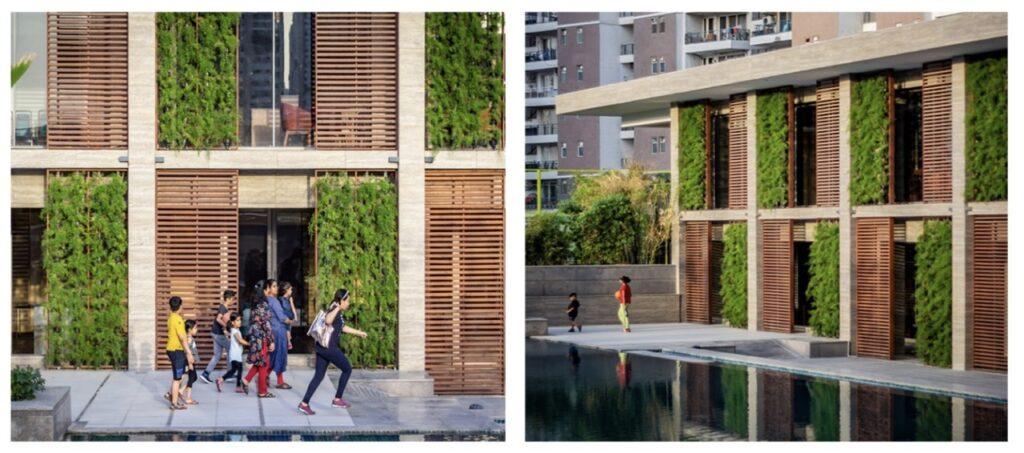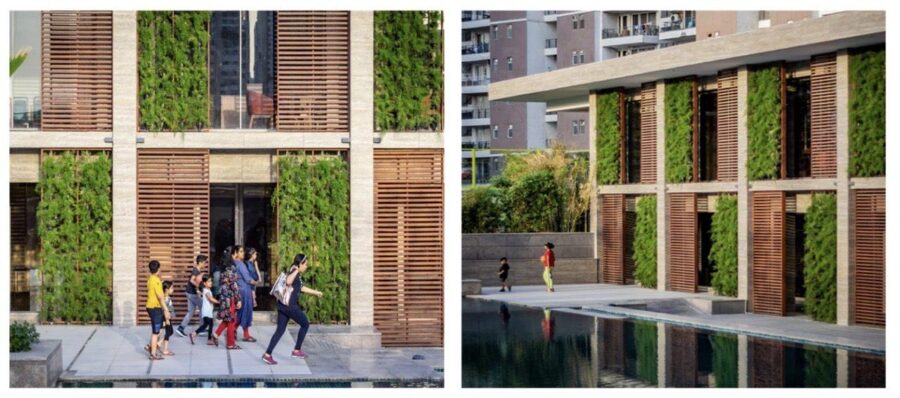The act of building is not one that can be taken lightly. No matter the scale, building processes carry impact; each act of construction consumes resources, transforms the location where it is carried out, and affects multiple groups of people. These impacts compound quickly – despite significant efforts made towards mitigation, construction activities still contribute to 23% of air pollution, 40% of drinking water pollution, and 50% of landfill wastes.
On the other side of the equation, the design of a project plays a large part in shaping its users’ lives. This is not a poetic assertion – simple factors such as the amount of natural light a room receives, or the rate at which air circulates in and out of a space, can affect users’ productivity, mood and cardio-vascular health.
Architecture shapes everything in contact with it, which makes our practice a socio-cultural responsibility just as much as it is an economic activity. As architects, we put people first. Yet this approach alone does not offer solutions that ensure sustainability, resilience and wellness.
In the nearly twenty years of BASICS’ existence, we’ve tested out countless design principles to see which serves our stakeholders the best. Each iteration has pointed us in the direction of Nature-Integrated Design – an approach we have developed as a guiding principle for all our projects.
What is Nature-Integrated Design?
Simply put, Nature-Integrated Design connects humans with nature through the built environment. Human shelters were created to protect people from nature’s wrath, but we’ve come a long way since – existing on the other side of the spectrum where buildings are designed to shut people away from the outdoors. It is clear that what we really need is a happy medium, and Nature-Integrated Design is the framework we use to achieve this balance.

Nature-Integrated Design addresses humans and the natural world in a holistic context. We focus on the simple but profound benefits of natural elements – the value of sunlight, fresh air, greenery, and pleasant views – and develop each project, from the conceptual stage itself, to maximise these benefits.
Why do we need Nature-Integrated Design?
At present, people spend up to 80-90% of their time indoors. This is in stark contrast to how people led their lives even a century ago, despite being intuitively aware of how we can be healthier and more productive when connected to nature.
This intuition has been the driving force behind several design styles, such as organic architecture, biomimetics, biophilia and more. Not only have these styles helped reimagine man’s relationship with nature, they have yielded substantial advantages as well.

The rationale is simple: we place human life, natural elements and the built environment on the same level. We view them as components of a single system, which must support one another to thrive.
How do we implement Nature-Integrated Design?
In nature, each organism does its part to support a larger ecosystem. Abstracting this approach for building practices, we identify avenues to reinforce the connection between humans and nature in recognition of the fact that our wellbeing depends on it.
While each project merits its own set of parameters to achieve nature-integration, our design interventions can be broadly classified as follows:

Visual connection and access to nature: Depending on the site and its surroundings, some projects naturally enjoy a stunning backdrop of rolling green hills or sprawling gardens. In most cases, however, architects must create engaging vistas and respite zones for the benefit of their users. These vistas can range from unbroken sightlines across a central courtyard, or strategically placed balconies to capture shade from a neighbouring tree. Even strategically placed indoor planters can help reinforce users’ connection to natural elements and uplift their mood.

Natural light and ventilation: Light and air are two fundamental elements that determine wellness and modulating both is crucial to creating comfortable spaces. Excess light produces glare, whereas inadequate light can cause eye strain, unregulated circadian rhythms, and nutrient deficiencies. Similarly, stale air due to poor ventilation can cause a host of problems ranging from brain fog to respiratory illnesses. Nature-Integrated Design navigates these extremes to find solutions that not only optimise users’ access to light and ventilation, but also the means to do so in a sustainable and resource-efficient manner.
Appropriate Material Choices: We opt for natural materials as far as possible, opting for their closest nature-friendly alternative whenever truly necessary.Viewed through this lens, material choices can be deemed appropriate for two reasons:

- the effect of a material
- the lifecycle of a material
The effect of a material is reinforced through its colour, finish and application. These may include unvarnished wood, stone tiles, or even green walls – each adding their unique tactile and visual qualities to a space. On the other hand, the lifecycle of a material determines their effect on the environment.
Locally sourced or upcycled materials, for instance, bring down the carbon footprint of the project. The palette for any project must contend with both concerns to source materials that are suited to the users’ needs, as well as environmentally-sound.

Climate Response: Usually implemented through a combination of the above interventions, climate response has emerged as a crucial facet of Nature-Integrated Design. With climate change being the biggest challenge of our times, we can no longer afford to create glass boxes that radiate heat and sap resources. Through strategic decision-making at the programme level itself, the lifespan of a building – as well as its performance against a host of sustainability indices – can be enhanced.
This is by no means an exhaustive list. Each project presents unique challenges, which give rise to unique opportunities. In each case, however, our target remains the same – to bring humans closer to nature, and to minimise the negative impact of building activities on the natural environment. As we close on two decades of practice, our belief in the efficacy of this framework remains unwavering.





Leave a Reply
Your email is safe with us.